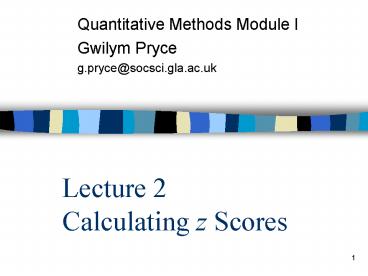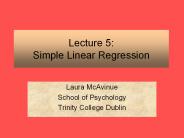Lecture 2 Calculating z Scores - PowerPoint PPT Presentation
Title:
Lecture 2 Calculating z Scores
Description:
Quantitative Methods Module I Gwilym Pryce g.pryce_at_socsci.gla.ac.uk Lecture 2 Calculating z Scores Notices: Register Class Reps and Staff Student committee ... – PowerPoint PPT presentation
Number of Views:83
Avg rating:3.0/5.0
Title: Lecture 2 Calculating z Scores
1
Lecture 2Calculating z Scores
- Quantitative Methods Module I
- Gwilym Pryce
- g.pryce_at_socsci.gla.ac.uk
2
Notices
- Register
- Class Reps and Staff Student committee
3
Introduction
- We have looked at the characteristics of density
functions, one that particularly interests us,
the normal distribution - Though we have already looked briefly at the
standard normal curve, today we shall look in
depth at the practicalities of calculating z
scores and using them to work out probabilities.
4
Aims Objectives
- Aim
- To consider the practicalities of the standard
normal curve - Objectives
- by the end of this lecture students should be
able to - Work out probabilities associated with z scores
- Work out zi from given probabilities
- Derive zi and associated probability from given
values of a normally distributed variable x - Apply zi scores to sampling distributions
5
Plan
- 1. Find probabilities from zi
- Tables
- SPSS
- 2. Find zi from a given probability
- z that bounds upper or lower tail area
- z that bounds central area
- 3. Find zi probabilitiy from xi N(m,s)
- 4. Applying z scores to sampling distributions
6
Find probabilities from zi
- 1.1 Using Published tables
- Most stats books have z-score tables which allow
you to find Prob(zlt zi ) - Or sometimes they list
- Prob(0ltzlt zi )
- Prob(zlt zi lt 0)
- Symmetry of the normal curve means that its easy
to find any probability from any of these.
7
e.g. Prob(z lt -1.36)
- 1. Draw curve
- 2. Work out what value in the tables will help
you. - 3. Compute the desired probability by
manipulating the value from the tables.
8
e.g. Prob(z gt 1.36)
- 1. Draw curve
- 2. Work out what value in the tables will help
you. - 3. Compute the desired probability by
manipulating the value from the tables.
9
e.g. Prob(z lt 1.36)
- 1. Draw curve
- 2. Work out what value in the tables will help
you. - 3. Compute the desired probability by
manipulating the value from the tables.
10
(No Transcript)
11
(No Transcript)
12
Using the macro commands in the lab
- 1st click Macros
- 2nd Open syntax window
- 3rd type in command
- pz_lt_zi (1.36) . calculates the probability
that z is less than 1.36 will result in the
following output - Prob(z lt zi) for a given zi
- ZI PROB
- 1.36000 .91309
13
Prob(z lt 1.36)
14
pz_gt_zi calculates the probability that z is
greater than zi
- e.g. pz_gt_zi (-2.897) .
- will result in the following output
- Prob(z gt zi) for a given zi
- ZI PROB
- -2.89700 .99812
- which says that 99.812 of z lie above 2.897.
15
(No Transcript)
16
pz_lg_zi calculates the probability that z is
less than ziL or greater than ziU
- e.g. pz_lg_zi zil(-2) ziu(2).
will result in the following output - Prob((z lt ziL) OR (z gt ziU)) for a given zi
- ZIL ZIU PROB
- -2.00000 2.00000 .04550
- which can be interpreted as telling us that just
4.55 of z lie outside of the range 2 to 2.
17
(No Transcript)
18
pz_gl_zi calculates the probability that z is
greater than ziL AND less than ziU
- e.g. pz_gl_zi zil(-2) ziu(2).
- results in the following output
- Prob(ziL lt z lt ziU)) for a given zi
- ZIL ZIU PROB
- -2.00000 2.00000 .95450
- which tells us that 95.45 of z lie in the range
2 to 2.
19
(No Transcript)
20
2. Find zi from a given probability
- 2.1 Using tables
- You can look up the areas in the body of the
table and find the z value that bounds that area - You must be careful to restate your problem in a
way that fits with the probabilities reported in
the table however
21
E.g. Find zi s.t. Prob(z lt zi) 0.06
22
E.g. Find zi s.t. Prob(z lt zi) 0.06
- This is a small area in the left hand tail so zi
is going to be negative
23
(No Transcript)
24
Find zi s.t. Prob(z gt zi) 0.06
- because the normal distribution is symmetrical,
we can look at the upper tail of the same area
know that the z value will be of the same
absolute value. - I.e. Find zi s.t. Prob(z gt zi) 0.94
25
Use zi_lt_zp and zi_gt_zp Macros
- zi_lt_zp p (0.06).
- Value of zi such that Prob(z lt zi) PROB when
PROB is given - ZI PROB
- -1.55477 .06000
26
- zi_gt_zp p (0.06).
- ValuValue of zi such that Prob(z gt zi) PROB
when PROB is given - ZI PROB
- 1.55477 .06000
27
(No Transcript)
28
2.3 z that bounds central area
- Find the value of zi such that Prob(-zi lt z lt zi)
0.99 - How would you do this using tables?
29
Using Tables
- First find half of the central area
- Area of half of central area 0.99 / 2
0.495 - Then take that area away from 0.5 to give the
lower tail area - 0.005
- Then find z value associated with that area
- Look up 0.005 in the body of the table
- z -2.57
30
(No Transcript)
31
- zi_gl_zp p(0.99) .
- Value of zi such that Prob(-zi lt z lt zi) PROB,
when PROB is given - ZIL ZIU PROB
- -2.57583 2.57583 .99000
- which tells you that the central 99 of z values
are bounded by and 2.576
32
3. Find zi probabilitiy from xi N(m,s)
- For a particular value xi of a normally
distributed variable x, we can calculate the
standardised normal value, zi, associated with it
by subtracting the population mean, and dividing
by the population standard deviation,
33
- So, we can standardise any value of x provided we
know the population mean and population standard
error of the mean. - And once you have standardised a value (i.e.
converted it to a z-score), then you can use it
to calculate probabilities under the standard
normal curve knowing that these probabilities
correspond to probabilities under the original
distribution of x.
34
E.g. You know that the height of all 18 year old
males is normally distributed with a mean of 1.8m
and a standard deviation of 1.2m. What proportion
of 18year olds are lt 2m tall?
- xi height of 18 year olds 2
- m population mean of x
- mean height of all 18yr olds
- 1.8
- s population standard deviation of x.
- 1.2
35
Because height is normally distributed, we know
that Prob(height lt 2m) Prob(z lt zi)
- where zi is the standardised value for x 2.
First we need to calculate zi - Now that we have calculated zi 0.1667, we can
calculate Prob(height lt 2m) Prob(z lt 0.1667) - Using the pz_lt_zi macro, we get
- pz_lt_zi (0.1667).
- Prob(z lt zi) for a given zi
- ZI PROB
- .16670 .56620
- That is, 56.62 of 18year old males are less than
2m tall.
36
4. Applying z scores to sampling distributions
- natures questionable tendency to normalcy ?
limited use of z scores - if it were not for the CLT
- Sampling distributions of means are always
normally distributed provided n is large. - ? following formula for z
37
If the sample mean inside leg of gerbils is
2.7cm, the population mean is 3cm and the
standard error of the mean is 4, what is the
z-score for the sample mean? What proportion of
all possible large samples of gerbils have inside
leg measurements of less than 2.7cm?
38
Prob(sample mean lt 2.7) Prob(z lt -0.075)
- zi_lt_zp p (-0.075).
- Prob(z lt zi) for a given zi
- ZI PROB
- -.07500 .47011
- That is, 47.01 of all possible sample mean
inside leg lengths are less than 2.7cm.
39
- So the CLT z score allow us to say something
about sample means.
40
SummaryToday we have discovered
- 1. How to find probabilities from zi
- Tables
- SPSS
- 2. How to find zi from a given probability
- z that bounds upper or lower tail area
- z that bounds central area
- 3. How to find zi probabilitiy from xi N(m,s)
- 4. How to z scores can be applied to sampling
distributions
41
Reading
- Pryce, chapter 3
- MM section 1.3 and chapter 5.































